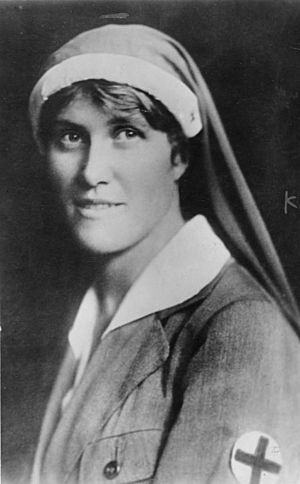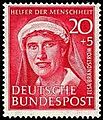Elsa Brändström facts for kids
Elsa Brändström (born March 26, 1888 – died March 4, 1948) was a kind Swedish nurse and a person who loved helping others (a philanthropist). She became famous as the "Angel of Siberia" because of her amazing work.
Contents
Elsa's Early Life and Becoming a Helper
Elsa Brändström was born in Saint Petersburg, Russia. Her father, Edvard Brändström, worked for the Swedish Embassy. When Elsa was three, her family moved back to Sweden. Later, in 1906, her father became the Swedish Ambassador in Russia, and they returned to St. Petersburg.
Elsa spent her childhood in Linköping, Sweden. She studied to become a teacher in Stockholm from 1906 to 1908. After her mother passed away in 1913, Elsa was in St. Petersburg when World War I started. She decided to volunteer as a nurse for the Russian Army.
Helping Prisoners in World War I
In 1915, Elsa went to Siberia with her friend and fellow nurse, Ethel von Heidenstam. They worked for the Swedish Red Cross. Their goal was to bring basic medical care to German and Austrian soldiers who were prisoners of war (POWs).
Life for these prisoners was incredibly hard. Many died from cold, hunger, and sickness. When Elsa visited the first camp, she saw how terrible the conditions were. She decided right then to dedicate her life to helping these soldiers. Many of them were very sick with Typhoid fever. They saw Elsa, a tall, blue-eyed, blond-haired nurse, as a true helper. This is how she earned the nickname "Angel of Siberia".
Back in St. Petersburg, Elsa started a Swedish aid group. However, her work became very difficult when the October Revolution began in 1917. In 1918, the Russian government took away her work permit. But Elsa didn't give up! She made several more trips to Siberia. In 1920, she was arrested in Omsk and accused of being a spy. At first, she faced a very serious punishment, but it was later changed, and she was held for a while.
After her release, Elsa returned to Sweden. On her way, the German government gave her a special welcome. Once in Sweden, she worked hard to raise money for former POWs and their families. Later, she moved to Germany.
Helping After the War
In 1922, Elsa published a book about her experiences called Among prisoners of war in Russia & Siberia. She then helped former POWs at a special recovery center in Saxony, Germany. She even bought a mill called Schreibermühle near Lychen. She turned it into a place where former prisoners could live and get back on their feet. The mill had lots of land for growing food, which was very helpful because money was not stable in Germany at that time.
In 1923, Elsa traveled across the United States for six months. She gave talks to raise money for a new home for children whose parents were German and Austrian POWs who had died or been deeply affected by the war. She raised an amazing US$100,000 and visited 65 towns! At one stop, she spoke about her exciting and challenging experiences in Russia and Siberia.
In January 1924, she opened a children's home called Neusorge in Mittweida. It could care for over 200 orphans and children in need. Elsa had promised many dying German soldiers in Siberia that she would look after their children.
In 1929, Elsa married Heinrich Gottlob Robert Ulich, a German professor. They moved to Dresden. In 1931, she sold the Schreibermühle and gave her Neusorge home to a welfare center. She also started the Elsa Brändström Foundation for Women. This foundation gave scholarships to children from Neusorge. On January 3, 1932, her daughter, Brita, was born in Dresden.
In 1933, Robert Ulich got a job at Harvard University, so the family moved to the USA. There, Elsa continued to help German and Austrian refugees who were new to the country. In 1939, she opened the Window-Shop, a restaurant in Cambridge, Massachusetts, that gave jobs to refugees.
World War II Efforts
When World War II ended, Elsa started raising money again. This time, it was for women and children in Germany who were starving and homeless. She worked with organizations like CARE International and CRALOG. A lot of money was collected, especially from Americans of German heritage. She also went on a final speaking tour in Europe to help the "Save the Children Fund."
Passing Away
Elsa Brändström became ill and could not make her last planned trip to Germany. She passed away in 1948 from bone cancer in Cambridge, Massachusetts, at 59 years old. Her daughter Brita stayed in the USA, but her husband Robert returned to Germany, where he died in 1977.
How Elsa is Remembered
Because of her dedication to helping POWs, Elsa Brändström became known as a "patron saint" for soldiers. In Germany and Austria, many streets, schools, and buildings are named after her.
General Alfred Knox, a British military officer, once said: "The war has brought about many heroines in various nations, but in my opinion, never again someone, who is more worthy of being honoured than Elsa Brändström."
Elsa received many awards and honors. These included the Silber Badge of the German Empire and the Golden Seraphim Medal. She was also nominated five times for the Nobel Peace Prize!
Monuments and Tributes
On September 16, 1965, a special ceremony took place in Vienna, Austria. A monument to Elsa Brändström was unveiled in Arne-Karlsson-Park. This statue, created by sculptor Robert Ullmann, shows how grateful people were for her amazing work helping German and Austrian prisoners during World War I.
Elsa's Books
- Elsa Brändström: Bland Krigsfångar i Ryssland och Sibirien 1914–1920, Norstedt, Stockholm (1921).
- Elsa Brändström: Unter Kriegsgefangenen in Rußland und Sibirien – 1914–1920, Leipzig, Koehler & Amelang (1927)
- Hanna Lieker-Wentzlau (ed.) and Elsa Brändström: Elsa Brändström-Dank – Das Ehrenbuch nordischer und deutscher Schwesternhilfe für die Kriegsgefangenen in Sibirien, Becker/Säeman/Heliand
Images for kids
-
Monument to Elsa Brändström in Vienna.
See also
 In Spanish: Elsa Brändström para niños
In Spanish: Elsa Brändström para niños




